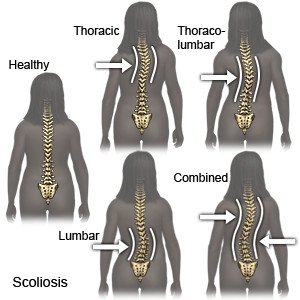Scoliosis in Children
Medically reviewed by Drugs.com. Last updated on Aug 4, 2025.
What is scoliosis?
Scoliosis is an abnormal curving of the spine. Scoliosis can develop at any age in children but often starts during adolescence.
 |
What increases my child's risk for scoliosis?
In most cases, the cause of scoliosis is not known. The following may increase your child's risk:
- Certain birth defects
- A family history of scoliosis, especially if both parents had it
- A broken bone, radiation, or surgery of the spine
- A disease that causes problems in muscle control or activity, such as cerebral palsy, muscular dystrophy, or Marfan syndrome
What are the signs and symptoms of scoliosis?
- Leaning to one side when standing, sitting, or walking
- One shoulder blade, set of ribs, or hip that sticks out more on one side than the other
- Shoulder or waist that is higher on one side than the other
- Sunken chest, rounded shoulders, and swayback
- Trouble breathing or back pain if scoliosis is severe
How is scoliosis diagnosed?
Your child's healthcare provider will ask if your child has any other health conditions. The provider may ask about your child's growth and development. Tell the provider about any surgery your child had. The provider will examine your child and ask him or her to bend forward. Your child's shoulders, hips, legs, and ribs will also be checked. Your child may also need the following tests:
- X-rays may be used to check the curve and shape of your child's spine. X-rays may show other conditions, such as broken, incomplete, or fused bones. They may also show if your child is still growing.
- An MRI or CT scan may be used if x-rays do not give enough information about your child's spine. Your child may be given contrast liquid before the pictures are taken to help your child's spine show up better in the pictures. Tell the healthcare provider if your child has ever had an allergic reaction to contrast liquid. Do not let your child enter the MRI room with anything metal. Metal can cause serious injury. Tell the healthcare provider if your child has any metal in or on his or her body.
How is scoliosis treated?
Treatment depends on when the condition started and how severe it is. The goal of treatment is to correct or control the curving of the spine and prevent more problems. If the curve is mild or your child is almost fully grown, his or her healthcare provider may recommend regular visits to monitor the scoliosis. Your child may need any of the following:
- A cast or brace may help keep your child's spine from curving or stop the curving from getting worse. Most braces are small and light and may be worn under clothes. Sometimes a cast is used first and replaced with a brace after a few months. The brace may be adjusted as your child grows.
- Surgery may be needed if the curve is severe and a brace has not helped. Healthcare providers may place rods, screws, or wires to help straighten the spine.
Call your local emergency number (911 in the US) if:
- Your child has trouble moving his or her legs.
- Your child's legs are numb, weak, or he or she cannot feel them.
When should I seek immediate care?
- Your child has shortness of breath, coughing, wheezing, or noisy breathing.
- Your child has back pain that is worse or does not go away after he or she takes pain medicine.
- Your child has problems urinating or having bowel movements.
When should I call my child's doctor?
- Your child has a fever.
- You have questions or concerns about your child's condition or care.
Care Agreement
You have the right to help plan your child's care. Learn about your child's health condition and how it may be treated. Discuss treatment options with your child's healthcare providers to decide what care you want for your child. The above information is an educational aid only. It is not intended as medical advice for individual conditions or treatments. Talk to your doctor, nurse or pharmacist before following any medical regimen to see if it is safe and effective for you.© Copyright Merative 2025 Information is for End User's use only and may not be sold, redistributed or otherwise used for commercial purposes.
Learn more about Scoliosis
Treatment options
Symptoms and treatments
Further information
Always consult your healthcare provider to ensure the information displayed on this page applies to your personal circumstances.
